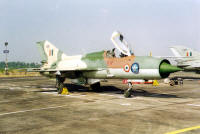
MiG-21
Click here to view this page in frames
Origin: Russia.
NATO Codename: Fishbed.
Indian Name:
Trishul, Vikram, Bison.
Type: Single-seat, multi-role fighter.
Current versions in IAF service: FL, Bis, M/MF
M/MF; Multi-role version with one R-11-300 turbojet with 13,688 lbs. of thrust. Has 4 pylons which can carry external fuel tanks, air-to-air missiles or twin barrel guns. Has a zero speed, zero altitude ejection seat. The MF variant has a R-11F2S-300 turbojet, otherwise similar to the 'M' variant.
Bis; Advanced variant with further improved avionics indicated by the ILS antennae under the nose and on the fin tip.
Bison; Most advanced variant with further improved avionics incl MFDs, HOTAS, RWRs and BVR Capability.
U/UM/US-Mongol; Two seat trainer version with cockpits arranged in tandem, larger main wheels, one piece forward air brake and pilot boom repositioned above intake. Has no cannon armament. Has a broader-chord vertical tail surfaces and a under brake parachute housing, with a deeper dorsal spine and no dorsal fin fillet. One R-13 turbojet and 4 under-wing store pylons.
Accommodation: Pilot on zero/zero ejection seat with spring loaded arm at top which ensures that seat cannot be operated unless hood is closed. The canopy has a small rear view mirror, a flat bullet proof windscreen and and air-conditioned cabin. Armour plating forward and aft of cockpit. The Bison is equipped with a frameless windshield and a 'Bubble' Canopy.
Avionics: Standard avionics include automatic radio compass, IFF and a Sirena-3 RWR system. The gyro gun-sight maintains precision up to 2.75 g. Automatic ranging can be fed into gun-sight. Full blind flying instrumentation with attitude and heading indicators given by radio controlled gyro platform. The aircraft also has a search & track radar.
Engine: Depends on aircraft variant.
Maximum Speed: Mach 2.05
Service Ceiling: 15,250 meters (50,000 feet)
G Limit: ?
Combat
Radius:
Internal fuel - 1100 km; 683 miles.
.....................With internal fuel & four 250 kg. bombs - 370 km;
230 miles.
.....................With two 250kg bombs and drop tanks - 740 km; 460
miles.
.....................A ferry range with three fuel tanks - 1800 km;
1118 miles.
Armament: One twin-barrel 23mm GSh-23 gun with 200 rounds, in the belly pack. Has four under wing pylons for weapons or drop tanks. Can carry air-to-air missiles, rocket pods, bombs, drop tanks and other types of ordnance.
Maximum External Stores Load:
FL; 500 kg; 1102 lbs.
..........................................M/MF; 2000 kg; 4409 lbs.
..........................................bis version; 2000 kg;
4409 lbs.
..........................................U/UM/US version; 1000 kg;
2204 lbs.
Self Defence: Depends on the version of the aircraft.
Comments:
The MiG-21 forms 16 operational squadrons, in a number of variants, and is the
ageing backbone of the Indian Air Force. 125 MiG-21bis are selected to be
upgraded by MiG-MAPO and HAL. Reportedly another 50 aircraft will be upgraded,
after the 125 initial order. The first two aircraft were upgraded in Russia,
with the first test flight occurring in October 1998 and trials of the
medium-range R-73RDM2 and the long-range R-77RVV-AE air-to-air missiles being
conducted in February 1999. These two aircraft have returned to India and as of
July 2001, four aircraft have been upgraded adding to the first two. Test
flights began in June 2001, while HAL has confirmed that modernisation is taking
place. All aircraft will be upgraded locally at HAL and will be completed by
2004. The aircraft will be designated by the IAF as the MiG-21
Bison.
The upgrade consists of Phazotron NIIR's Kopyo multimode, X-band pulse Doppler radar, new nosecone, new canopy, single-piece windshield and new canopy made of stressed acrylic composites, Sextant's TOTEM RLG-INS with NSS-100P GPS embedded GPS receivers, El-Op HUD, infrared search and track system (IRST) from Russia's URALs optical-mechanical plant, two Sextant MFD-55 LCD displays, autopilot, radar warning receivers (RWR), digital flight data recorder, new liquid air cooling system, HOTAS controls, a SURA helmet mounted sight, stores management system, digital air data computer system, short range radio navigation system, new HF/VHF/UHF radios, twin conformal Vympel flare dispensers (26mm, 120 rounds) and a new electric power supply system. Reportedly the new RWR to be fitted, is an indigenous system developed by DRDO and goes by the name Tarang. A modified version of this RWR will be used aboard the Su-30MKI.
The upgrade package was jointly developed and certified by the IAF, and Russia's Sokol Nizhny Novgorod aircraft building plant and the state-owned avionics testing & integration establishment.
Source: Jane's; Bharat-Rakshak; Aeronautics.ru
© Indian AF. Copyright Reserved.
Webmaster: Abhishek ( abhishek_chatterjee@mantrafreenet.com )